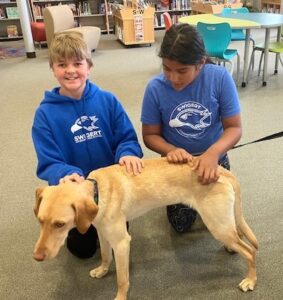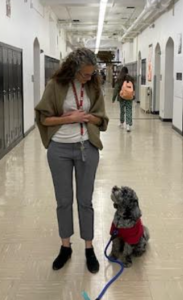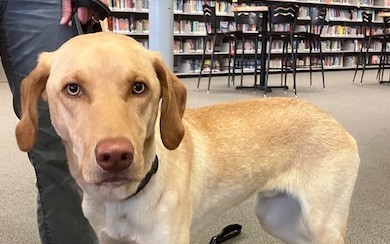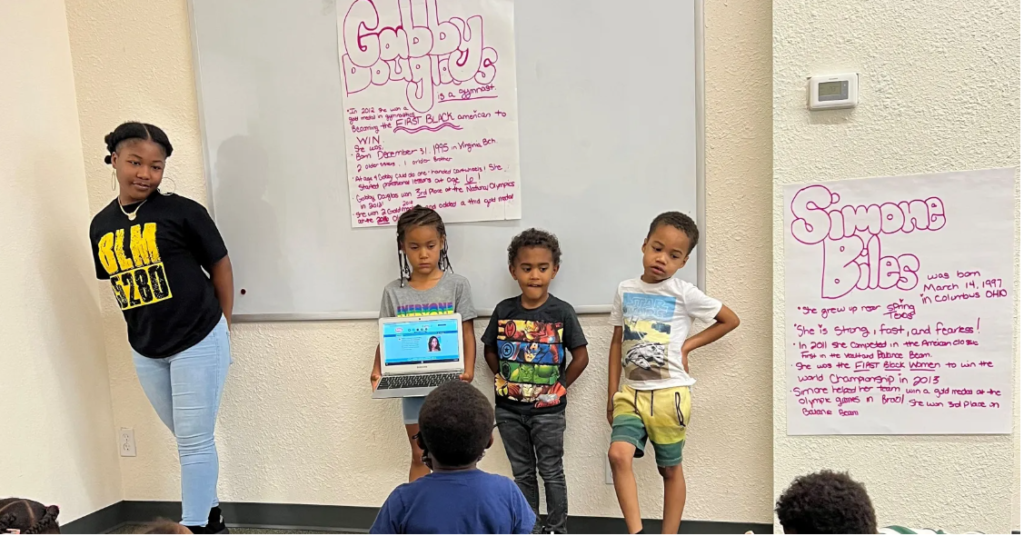(Cover photo: Buddy, Swigert International School’s new therapy dog. Photo: Brian Weber.)
Next fall Swigert International Elementary will add a Buddy to its staff.
He’s long, lean and blonde. He will help support students who need a calming influence when unsteady emotions interfere with their learning.
And he has four legs.
Buddy, who’s nearly a year old, belongs to Swigert special education instructional coach Leslie Raynor. He’s a yellow lab, pointer, Weimaraner from the Rocky Mountain Lab Rescue. “We just call him super mutt,” Raynor says.
Buddy is training to be the school’s new therapy dog to assist students who experience social or emotional difficulties. Buddy will assume his duties in the fall.

“We are seeing more and more social/emotional needs in our students, and we are looking into different ways to support students with anxiety,’’ Swigert Principal Shelby Dennis says. “I also think we can set up opportunities for students to read to Buddy and increase their reading skills at the same time.’’
Facing worsening youth mental issues, more schools across the country have brought therapy dogs on board to help students cope, according to a story in Education Week in January 2023. They are becoming more common in schools throughout the metro area.
Some integrate the animals into academic work, using them in interventions for students with disabilities or as part of classroom engagement strategies. Therapy dogs are trained to provide support in a community environment, Ed Week says. They differ from service dogs, which are trained to assist individuals with specific tasks related to physical disabilities.

As far as anyone knows, Swigert and McAuliffe International (middle) School are the only Central Park schools with therapy dogs. At McAuliffe, gifted and talented coordinator Becky Middleton brought her family’s pet, Louis, on board about two years ago.
“Getting a social/emotional dog was not the intent,’’ Middleton says. “I was just ready for another dog and wanted it to be well trained.”
Training is critical to follow commands, be calm and comfortable in a variety of situations, while also possessing a friendly temperament. Raynor is putting Buddy through a programs like the ones Louis completed.
There’s the Canine Good Citizens Certification classes and then the Alliance of Therapy Dogs testing to get his therapy dog certification. Louis went even further passing Denver International Airport’s Canine Airport Therapy Squad’s (CATS) onboarding and worked at DIA for a while.
“The kids really like Louis,” Middleton says. “We go into classrooms. We’ve done recess duty. He hangs out in the teacher’s work room. Teachers come in for some puppy love.”
And he has his own morning routine.
“When arriving at school, he has to make his rounds to see his favorite people.” Middleton says. “I do yoga and Brain Bowl enrichments and the kids love it when I bring him.
“Louis loves it at McAuliffe, He’s been a Sun Devil (school mascot) since he was about a year old.”
A therapy dog can help make children more comfortable when talking about difficult topics, Raynor says. At times some students arrive at school already upset about something at home. Buddy may be able to help with touch therapy.
“It is calming to pet a dog while you’re talking if you’re emotionally distressed,’ Raynor says.
There also will be opportunity to teach responsibility, giving students a classroom job taking him for a walk around the playground and learning to care for a dog.
In addition, school psychologist Kim Irk has, for some time, wanted to incorporate a therapy dog into her work with individuals and small groups, Raynor said.
“It’s just the presence, the warm body, soft ears, soft head,’’ Raynor said. “He’s a lover. He really is.”
(The Foundation for Sustainable Urban Communities gives grants to Central Park schools.)




